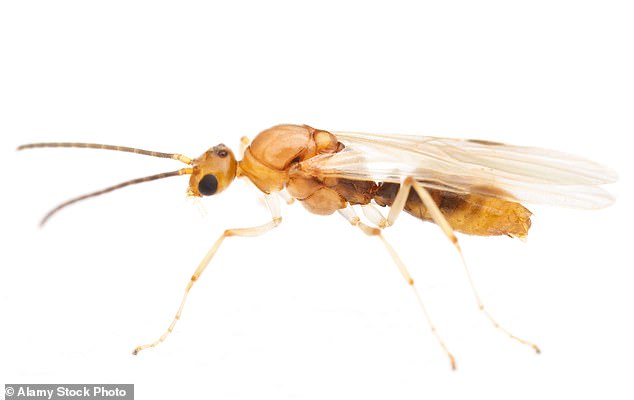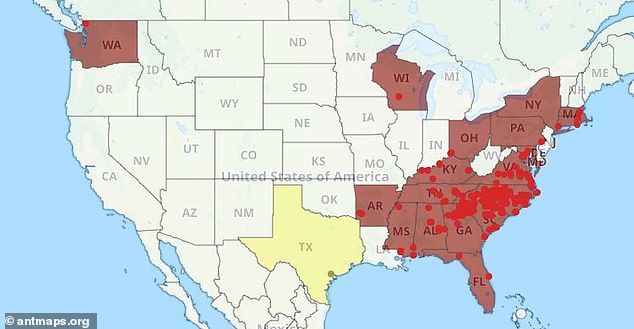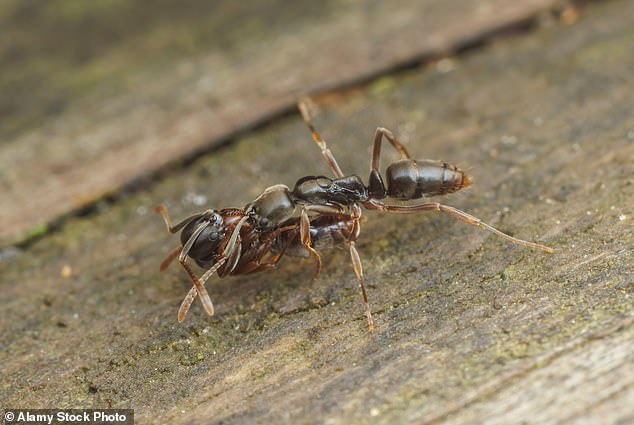Is Your Town on the List? Venomous Insect From China Spreads to 19 U.S. States!
- READ MORE: Snorkeler fortunate to survive after grappling with lethal marine animal
Authorities are raising concerns as invasive Asian needle ants continue to spread across various regions of the United States.
These insects, native to China , have a sting that can trigger severe allergic reactions, and in extreme cases, death.
This non-native species was initially observed in the United States over 90 years ago, however, its numbers have lately increased dramatically and are now expanding further. the East Coast , experts say.
They are currently present in 19 states: Florida , Georgia, Alabama , Mississippi , Arkansas , Tennessee, the Carolinas, Kentucky , Virginia, Ohio, Pennsylvania, Maryland , Connecticut , Rhode Island, Massachusetts , New York, Wisconsin, and Washington State.
The Asian needle ant is a species ranging from small to medium size, where both the workers and queens can grow up to one-fifth of an inch long. These ants have a glossy appearance, colored dark brown to black overall, but their antenna tips and legs display a paler shade of amber-brown.
The stings lead to 'severe pain' at the affected area which 'fluctuates over multiple hours.' However, some individuals have experienced discomfort even distant from the sting location, as stated by the USDA.
Certain individuals might also encounter anaphylaxis —a possibly fatal allergic reaction—as a consequence of being stung by an Asian needle ant.
These ants typically inhabit moist environments like spots underneath rocks or decaying timber; however, they've also been spotted in various locations including parklands, residential grassy areas, container gardens, wooden pile bases, and concealed within building supplies such as timbers, bricks, and paving stones.

These creatures have also been spotted rummaging through interiors of houses and structures and might become an issue as they increasingly intrude into residential areas in the coming years.
"We currently view it as a significantly medically relevant pest," said Dan Suiter, a professor of urban entomology at the University of Georgia. Fox Weather .
"It becomes somewhat more serious when an insect sting can be life-threatening for individuals who experience anaphylaxis," he noted.
Last year, Suiter responded to three cases of anaphylaxis in Georgians who had been stung by an Asian needle ant.
The signs of anaphylaxis encompass skin rashes, decreased blood pressure, narrowing of the air passages, enlargement of the tongue or throat, a feeble and quickened heartbeat, feelings of sickness, throwing up or loose bowels, lightheadedness or loss of consciousness, along with mental symptoms like a feeling of imminent danger.
Although instances of anaphylaxis have been documented in the United States, the proportion of Americans who have undergone this severe response is still unidentified.
However, individuals who have an extreme sensitivity to other stinging insects Bees, red ants, or mosquitoes might face a higher risk of experiencing a severe reaction to a sting from an Asian needle ant.
Research carried out within the natural habitat of this ant species—encompassing areas like China, Japan, and Korea—revealed that 2.1% of individuals who were stung experienced anaphylactic reactions.


This particular species is not typically considered aggressive, but they will sting as a means of defense when scared. Their stingers have the capability to penetrate fabric and make contact with bare skin.
Asian needle ants are most likely to be found indoors during the 'swarming' season, when these insects come out of hibernation to start reproducing. This seasonal phase usually starts in spring and extends through August.
This particular species has great adaptability and can flourish in environments ranging from temperate to cooler regions, whether they be located in bustling cities or quiet countryside settings.
"This adaptability in behavior enables the Asian needle ant to simultaneously infiltrate forests, rural regions, and urban settings," explained biologist and science writer Mary Bates in an article published in 2013 by the American Association for the Advancement of Science.
"Since it can endure lower temperatures, it has the potential to extend its reach across a wide array of regions," she noted.
Indeed, this is true. The Asian needle ant has created extensive colonies across the United States, with experts anticipating further expansion of their range.
Not only does this pose a risk to human health, but also to the environment.

Research indicates that this invasive species is pushing out native ant populations, leading to a reduction in both their numbers and variety in regions where Asian needle ants have taken hold.
Several of these indigenous ant species play key roles as seed distributors, transporting seeds away from their parent plants and facilitating the effective spread of those plant species.
The USDA reports that researchers have shown significant reductions in seed dispersal in forests affected by invasions of Asian needle ants.
Consequently, this invasive species might lead to significant, enduring adverse impacts on the forest undergrowth.
R Researchers are investigating and formulating methods to manage this rapidly growing ant population.
However, as with numerous invasive species, it seems the Asian needle ants are likely to remain, according to the USDA.
Read more
Post a Comment for "Is Your Town on the List? Venomous Insect From China Spreads to 19 U.S. States!"